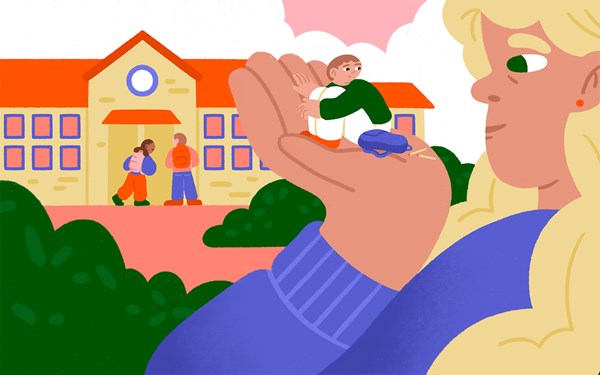How can you help a child if they're being bullied?
If your child or a child you know experiences bullying, it might make you feel angry, upset, or confused. We’ve got tips and suggestions on what you can do to help.
As a first step, there should be a shared understanding of what bullying is. You should agree that what’s happening isn’t right and shouldn’t continue.
How to talk to your child about bullying
- Choose the right time.
Make sure you can give your child your full attention. They might feel more comfortable talking in the car when you’re not looking directly at them. Or they might prefer to do it at home. Be led by how they’re feeling. - Listen and reassure.
Remain calm, even if you’re upset or angry. Your child might be feeling scared or embarrassed. You can help them respond to what’s happening in a way that feels right to them. - Help them get their feelings out.
Some children respond well to having a journal to draw or write their feelings in. This can be useful if they’re confused or ashamed about what’s happening. - Get more advice, if needed.
If you want more in-depth advice you can use our advice on talking about difficult topics.
Let them know who to ask for help
If they don't want to talk to you, suggest they chat with another trusted adult, such as a teacher or family member.
You could also suggest they contact Childline. They can get in touch online or over the phone, and a trained counsellor will support them. They don't have to give their name, and they can talk about anything that's worrying them.
Help them relax and take time out
Children and young people may lack confidence as a result of bullying. Remind them that it's not their fault; they're loved and valued. Help them find things to do that make them feel good. They might enjoy:
- listening to or playing music
- doing sport
- clubs or classes. Many libraries run free activities like games or Lego clubs.
Watch parents Catherine, David and Laura discuss how to navigate bullying.
If your child is being bullied in school

If your child is being bullied by someone they’re at school with, you can talk to the school. It doesn't matter whether the bullying is happening on the premises, outside or online. All schools have a responsibility to protect their pupils from bullying.
When you're aware that bullying is happening, the first person to contact should be the class teacher, form tutor, head of year or house tutor.
If your child is being bullied at a sports or activity club, talk to the person in charge.
It’s important to work in partnership with the school or activity club to resolve the situation effectively.
Arrange a meeting
- Ask for a copy of the school or club's anti-bullying policy, behaviour policy and complaints procedure. These may be available on the school or club's website.
- Take another person with you for support if it will help you.
- Take a notebook so you can remember what’s said.
- Bring any evidence you have of the bullying. If the bullying is happening online, this might include text messages and screenshots.
- Give detailed examples of the bullying's effect on your child.
- Make it clear you expect a response to help resolve the bullying.
- Ask for a copy of the school or club’s anti-bullying policy, behaviour policy and complaints procedure. These may be available to you before the meeting on the school or club’s website.
- Ask what action the school will take, making sure you all agree on what they plan to do.
- Arrange a date to speak to them again so you can see what progress has been made.
- Agree on a key person your child can talk to about new incidents or worries.
- Let the school or club know if you think the bullying involves ongoing harassment and intimidation or a hate crime, such as racism or homophobia. The school or club may inform the police if this is the case.
If the bullying continues
Ask if you can arrange another meeting to talk about what's happening. If this doesn’t sort things, follow the school’s complaint policy and consider writing a letter of complaint to the Headteacher.
Continue to keep a record of the incidents with as much information as you can, including:
- photographs of any physical injuries or damaged property
- the date, location and approximate time of each incident
- any contact (letters, emails etc) you’ve had with the school.
If that doesn’t resolve it, the advice is different depending on the type of school your child goes to. No matter the type of school, it’s important you follow their complaints policy.
Write to the chair of governors at the school address. The school office can provide the chair’s name if it’s not on the school website. Explain the situation and include copies of letters between you and the school and any evidence of the bullying.
If the bullying still isn’t dealt with, you can then make a formal complaint to the Local Education Authority (LEA) in the area where the child goes to school.
If you're unhappy with the head teacher's response, the Academy or free school should organise a hearing with a panel of at least three people not involved in the complaint.
For further advice, contact the Department for Education.
Write to the chair of governors at the school address. The school office can give you with the chair’s name if it’s not on the school website. Explain the situation and include copies of letters between you and the school, as well as any evidence you have of the bullying.
If the bullying continues, you can make a complaint to the Department for Education. They can consider reports to ensure a child's safety.
Report bullying online or on social media

As well as supporting your child emotionally, there are practical steps you can take if the bullying has taken place on an online platform, such as a social media app or online gaming chat room.
- A common response may be to completely remove your child's internet access or mobile phone. However, this is unlikely to solve things. They may try to access the internet elsewhere or secretly.
Instead:
- have open conversations
- review privacy settings
- use technology together rather than alone
- make sure your child knows how to block anyone who posts upsetting things. You can usually find details of how to do this in the help or online safety area under Settings.
- Report anyone bullying your child to the platform where it’s happened. Follow these links to contact some of the most popular social media platforms and learn more about blocking and reporting:
Instagram
Snapchat
WhatsApp
Facebook
Twitter/X
Skype - CEOP Education has advice on online safety for young people. It’s suitable for different age groups. The website shows children how to contact social media sites if they believe someone has posted something upsetting about them.
Report Remove
Worried about how to support a young person who has had a sexual image or video of themselves shared online? If they’re under 18, they can use Childline and the Internet Watch Foundation's discreet Report Remove tool to see if it can be taken down. Young people can get support from Childline throughout the process.
Report bullying videos shared online
Get in contact with the site the video was shared on as soon as possible. Social networks are more likely to take the video down if the child involved in the video or their parents make the report. Depending on their terms and conditions, they may be able to remove it from the site.
If the identity of any other children in the video is known, think about sharing it with the school or local police. They might want to take steps to make sure that these videos are not shared further.
Further resources
It also helps to chat with other parents or seek support about bullying.
The NSPCC Helpline is available on 0808 800 5000 or via help@nspcc.org.uk. Our child protection specialists can offer support and discuss any worries you have.
The child involved can contact Childline:
- by phone 0800 1111
- by email
- through online 1-2-1 counselling.
They won’t need to share their real name or email address.
Find out more
Illustration credits
Top banner and page body illustrations by Janice Chang.
Parenting advice row: see individual pages for details.






